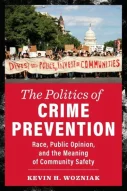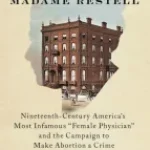The Politics of Crime Prevention: Race, Public Opinion, and the Meaning of Community Safety
Author: Kevin H. Wozniak
Publisher: NYU Press, 2023. 336 pages.
Reviewer: Luzi Shi | January 2024
In a democratic society, public opinion is an important social force in shaping public policies. Among the wide range of social issues, crime topics easily grab media attention, influence community members’ everyday feelings and thoughts, and may form controversial ideological and political debates. The public is likely to think they are at least somewhat knowledgeable of the crime control policies and are ready to share what they think. In the meantime, political rhetoric and media portrayals of crime may heavily influence people’s crime perceptions, in addition to the crime reality. Politicians may take advantage of public opinion about crime for their own electoral considerations. This book is a detailed examination of public opinion about crime and criminal justice in the twenty-first century.
The author started this book with the background information that during the past few decades in the United States, coupled with punitive sentiments from the public and political elites’ law and order rhetoric about crime and safety, harsh crime control policies were established, and the crime control web was expanded. At the same time, after witnessing a longtime nationwide crime decline, the negative consequences of overly harsh penal policies, and recent chants for criminal justice reform, we may wonder how public opinion about crime and crime control has changed and shifted in more recent years. The author also reminded us that racial biases and stereotypes heavily influenced crime control policies in the United States, and our thoughts on these issues were likely divided by our social class and educational background. Today, we are still in a society facing critical social problems of racism and polarization.
In other words, the crime problem in the United States is not a problem at the individual level but a social problem deeply rooted in the American history of racial tensions and concentrated disadvantages. Facing the crime problem, politicians have used tough-on-crime rhetoric in the past few decades and advocated for harsh penal policies to shy away from the root causes of urban unrest. The crime-solving methods supported by political elites and implemented in most local jurisdictions have largely neglected nonpunitive alternatives. This past approach is in confrontation with the more recent social movements that ask for divesting more resources to revitalize the communities in need instead of continuing with harsher surveillance.
As we live in a democracy, we must ask what the people really want for criminal justice reform. Why do people think offenders commit crimes? What kind of criminological theories and crime prevention strategies do people agree with? Does what the political elites argue for align with public opinion? And will Blacks and Whites from different educational backgrounds see eye to eye on crime control solutions? What are the policy implications for politicians? In this book, the author uses data from six focus groups and one national survey of Black and White Americans to answer these questions.
Based on answers from the focus groups, respondents had mixed beliefs that crime was caused by both personal choices and structural factors. Many White participants supported providing financial assistance to people experiencing poverty, while many Black participants advocated that people should take care of themselves. The Black participants’ self-reliant crime solutions might reflect a lack of confidence in government-led solutions. The results indicate that public opinion of crime and criminal justice may still vary depending on a person’s own demographic background. This racial divide was also shown in the national survey results, as a higher percentage of Black respondents than White respondents supported investment in community institutions rather than criminal justice institutions. The author further compared secondary data across different years and found that fewer participants today seemed to attribute the cause of crime to external factors compared to decades ago. This change may be driven by popular punitive policies in existence over the past few decades and popular languages in the media that depict people who need help as undeserving.
Using racial priming, politicians may frame poverty in urban areas as a matter of laziness among the minoritized group, making the ironic claim that giving more resources to poor people would make them lazier and that the residents do not deserve help from the government. The racial priming theory posits that the public especially supports policies that implicitly allocate fewer resources to poorer neighborhoods, thus covering up any explicit racism. Analyzing results from an experiment embedded in the national survey, the author found that descriptions of communities using implicit racial framing, such as “high crime” and “high poverty,” did not produce large differences in the responses. Surprisingly, respondents were more supportive of criminal justice rather than alternative community institutions when explicitly told that the funding would go to African-American communities. Among the focus groups, the author found that the participants, especially White participants, avoided discussing race and concentrated neighborhood disadvantages and instead claimed that crime was universal. The cue of African American communities also triggered backlashes among wealthier White respondents who initially supported more resources allocated to impoverished neighborhoods. Their concern was that the funding might be mismanaged. These kinds of claims reflected “colorblind racism” and indicated that the racial divide in public opinion about crime and crime control still existed decades after the success of the Civil Rights Movement.
Despite the possible backlash of racial framing, results from the national survey and focus groups showed that participants generally supported nonpunitive alternatives to reduce poverty and crime. This finding is at odds with many punitive crime control policies that are in place. This may be explained by the possibility that politicians only cater to the opinions of active voters, not those of the general public. To evaluate this possibility, the author examined whether punitive preferences differed across voters versus nonvoters. Compared to the nonvoters, Republican voters had more conservative policy preferences, such as lower support for resources directed toward public schools and healthcare and higher support for law enforcement. Independent voters had similar patterns of choices to those of the Republican voters. White voters were less likely to fully endorse community institutions. Combined with results from other demographic groups, the findings suggested that the current punitive policy practice aligned more with the policy preferences of Republican voters, independent voters, and White voters.
Given that policymakers largely neglect the criminal justice policy preferences of Democrats and independent nonvoters, the next question to ask is when politicians’ crime control policy choices go against public opinion, whether or not such disagreement would be a dealbreaker to influence the voters’ choices. Results showed that respondents largely welcomed it when the politician supported community institution investment rather than criminal justice institutions. This result was consistent across party and racial lines. The politician who prioritized criminal justice institution investment only got more support among respondents who took a colorblind view of racial inequality in the crime control system and believed the system treated people fairly.
Taken together, findings in this book showed that most Americans held a pragmatic view of solving the crime problem. However, many political elites and policy-makers only pay attention to the punitive aspect of public opinion. Moving forward, scholars and researchers should measure the public’s preferences more comprehensively to reveal the diversity of thoughts among the American public. Any policy reforms in the criminal justice arena should also involve a discussion about the influence of slavery and systemic racism on the American criminal justice system and help people understand that advocating social justice not only benefits the racial minority but also all groups and society as a whole. In the conclusion chapter, the author further discussed several policy recommendations based on findings from this book and his interpretations of the relevant literature.
Throughout the discussion of the results, the author was very careful in detailing the meaning of statistical significance and how different concepts were measured and coded to the audience. The author also discussed the proper methodology to understand different types of research questions and the limitations of the methods used in the book. Just as this book filled in the research gap to understand current public opinion about crime and criminal justice, it is limited in that the data were cross-sectional in nature. Continued study and understanding of the topic and research question are still needed to track the changes in public preferences for crime control policies and other related alternatives. It is also important to analyze public opinion from different racial and ethnic groups.
Overall, both academic scholars and researchers who conduct public opinion and public policy research related to crime and criminal justice and community members who are interested in understanding more about the crime issue will find the content in the book helpful and easy to follow. Indeed, to make criminal justice policies truly based on evidence and democratic opinions, both policymakers and community members should be more aware of what the public truly wants for improving public safety and criminal justice and how to build solidarity in solving crime-related problems.
Luzi Shi is an Assistant Professor of Criminology and Criminal Justice at the University of Rhode Island.



